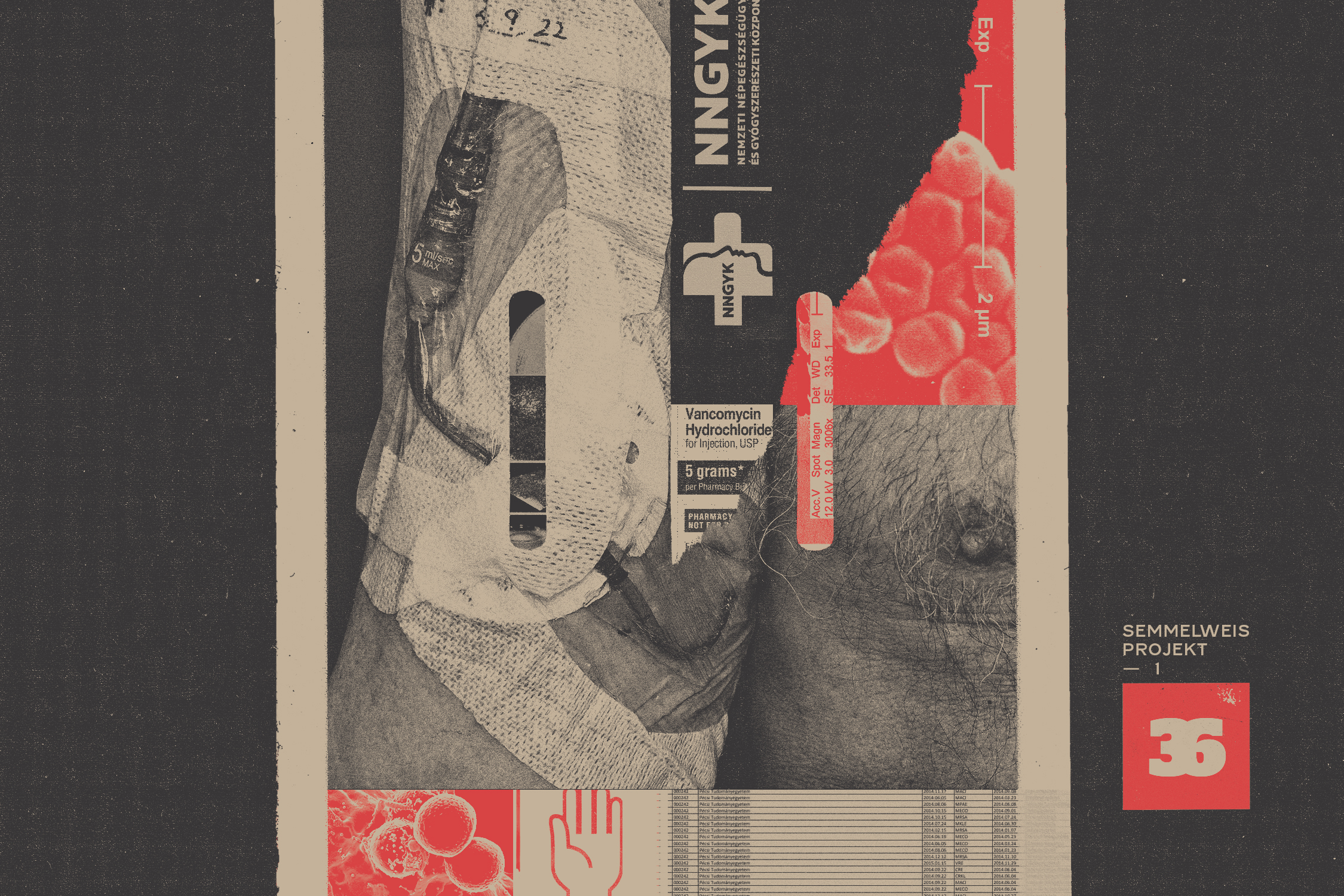Thousands of hospital patients are dying from terrible infections. Instead of addressing the situation, the government is working to cover it up

„If I stay here, I will die,” Bálint told his fiancé Marianna one summer day in 2015, as he had been suffering completely weakened from weeks of unstoppable diarrhea in the internal medicine ward of Budapest’s Péterfy Sándor Hospital.
The man, who was then in his thirties, athletic, and working as a mid-level manager for a company, was recovering from surgery when he contracted clostridium difficile – an infection that commonly spreads in hospitals. The pathogen is resistant to alcohol-based disinfectants and can spread rapidly among patients who are lying in hospital beds, often in diapers and unable to move – all it takes is a missed hand wash, a poorly disinfected door handle, or an uncleaned toilet.
Bálint was eventually cured in another hospital thanks to Marianna’s personal efforts, but he still suffered serious consequences from the infectious disease. He lost 8 months of his life, 40 kilos of his weight and developed three hernias.
Bálint is one of the thousands of people who in recent years have had to endure unnecessary suffering and even fatal complications from infections contracted in the very place where they went to recover: the hospital.
The number of hospital-acquired infections in Hungary has been rising steadily for many years. Hospitals are reporting more and more cases every year: in 2021, a previously unimaginable number of hospital-acquired infections were identified, some 16-21 thousand depending on the calculation, almost half of which resulted in death. In 1400 of these cases, the hospitals themselves admitted that the hospital-acquired infection played a role in the death of patients. Data from 2022 is not yet available.
However, these figures do not fully reflect the actual situation. In 2017 a detailed European study found that more than 78,000 hospital-acquired infections occur in Hungary every year, meaning that 3.5 percent of people admitted to hospital (almost one in 25 people) contract an infection. This is several times higher than the number of hospital-acquired infections reported by the National Centre for Public Health and Pharmacy (NCPHP).
While the problem is obvious, the government and state authorities are not making serious efforts to solve it. Moreover, they are doing everything they can to hide from patients – and even health workers – how serious the situation is, and which hospitals should pay more attention to reduce infections.
However, Direkt36 has uncovered many new details about hospital-acquired infections during a year-long investigation. The main findings of our investigation called the Semmelweis Project and our accompanying documentary film that will be released on the 11th of November, are the following:
- The Hungarian state and politicians are aware of the seriousness of the problem, but they put more energy into denying it and sweeping it under the carpet than solving it;
- using various methods, they intentionally hide what is going on in certain hospitals, not to “scare the public”;
- we prove that the situation is even more serious than what official statistics show and that in reality there are significantly more hospital-acquired infections;
- with the help of experts, we have prepared and are publishing a uniquely detailed analysis unprecedented in Hungary, based on data from a few years ago. Based on this analysis, it can be determined how certain departments of hospitals and the hospitals themselves compare to each other regarding hospital-acquired infections;
- we provide a closer look into what is happening behind the walls at several hospitals with exceptionally high numbers of infections in our rankings
- in several indicators, Hungary is underperforming in European comparison: small amount of hand disinfectants is used, there are few laboratory tests, few nurses, while there are still many multi-bed wards. These factors all contribute to the spread of infections.
For this investigation, we traveled from inside and outside Hungary, conducted more than 30 interviews and background interviews, and reviewed hundreds of pages of technical reports. We obtained tens of thousands of rows from previously undisclosed data on hospital-acquired infections, which we have made interpretable and analyzed over several months.
Our analysis was based on a raw database obtained from the state through a lawsuit by the Hungarian Civil Liberties Union (HCLU). It contains details of all reported hospital-acquired infections from three years before the Covid outbreak. The analysis was supported by a renowned biostatistician who spent many hours using several complex statistical models to produce the ranking of hospitals in the country.
In the meantime, we and the HCLU have filed a lawsuit for the latest data available on hospital-acquired infections, as the NCPHP continues its efforts to prevent its disclosure – ignoring the fact that several courts have already ruled that it cannot withhold these data.
The Ministry of the Interior, which is responsible for the healthcare system, has not responded to our questions, nor has the National Directorate General for Hospitals (NDGH), which oversees the hospital’s day-to-day operations. We have interviewed the Head of the NCPHP’s Hospital Hygiene and Regulatory Division, from who we quote several times in the article, but she stressed that they only make professional recommendations to hospitals and that it is up to the holspitals’ management and the state to provide the necessary resources.
What is spreading in the hospitals?
Pathogens spreading in hospitals are typically resistant to concentrated disinfectants and strong antibiotics. They are known as multiresistant bacteria and can cause serious illness by infecting elderly or immunocompromised people in hospital beds who are already ill.
There are a wide range of them, from acinetobacter baumannii, which can cause pneumonia, wound infections and urinary tract infections, to the bacteria MRSA which can cause abscesses and wounds to fester and heal difficultly. The latter is a type of pathogen which can enter the bloodstream and cause fatal blood poisoning (sepsis). Other common pathogens include the already mentioned clostridium difficile, a spore-forming bacteria, which causes foul-smelling, mucousy diarrhea and even severe inflammation of the intestines. Alcohol-based hand sanitiser by itself is not effective against it.
Pathogens can be spread by droplet transmission, faeces, wound drainage, through medical equipments and to a significant extent by the insufficiently disinfected hands of a doctor, nurse or visitor. Without proper hygiene, pathogens can linger on medical equipment, hospital toilets, door handles, shower curtains, bed linen, nurse call buttons - almost anywhere. Any invasive procedure, such as surgery, as well as a tube, catheter or cannula sticking out of a patient, poses a risk of infection. The longer a person spends in hospital, the more likely they are to become infected. And even die as a result.
This is a problem not only in Hungary, but in hospitals all over the world. More and more superbugs are appearing and spreading. The difference is in how countries' healthcare systems handle the problem: whether they tackle it and keep it under control, or succumb to it and sweep it under the carpet. There are not only billions spent on treatment, but also lives at stake: if done right, 30-50 percent of infections can be prevented, according to globally accepted estimates.
The personal story of Bálint presented at the beginning of this article illustrates, however, that not enough is being done in Hungary concerning prevention.
By 2015, the young man had been struggling with recurrent colitis for several years, leading to his admission to Péterfy Hospital, only to get worse after two weeks. He was visited every day at the hospital by his fiancé Marianna, who eventually managed to persuade the doctor to conduct an imaging scan. It revealed his bowel was perforated and his faeces had been leaking into his abdomen for weeks. He immediately underwent life-saving surgery.
Bálint was recovering in intensive care and was given antibiotics, yet after a few days he came down with another fever and complained of severe diarrhea.
"Afterwards, I went to the doctors again to say that we thought he had caught something, but they didn't listen to me", recalled his fiancé.
Marianna then gave up on the help of the hospital doctors and took Bálint's stool sample to a private laboratory herself. There it was confirmed that he had contracted clostridium difficile infection during his days in hospital. Although this allowed them to identify what was wrong with Bálint, Marianna claims the doctors frowned upon her private action.
"How can I do this when they are doing everything", Marianna explains the doctors' reaction after she showed them the results of the private lab.
Even though Bálint had been suffering from a severe clostridium difficile infection for weeks and a laboratory examination confirmed it, he was not isolated but placed in a three-bed ward in the internal medicine department. The man also had to use the same toilet down the corridor - every ten minutes - as everyone else. It was at this time he felt his survival depended on being placed in better conditions. Eventually, a private doctor helped him get admitted to Budapest’s Honvéd Hospital, where he ultimately completed his treatment with antibiotics.
Péterfy Sándor Hospital did not respond to Direkt36's request for comment.
Transparency is a bad idea according to the state
In the United States and England, patients can check the risk of infection with hospitals or the trusts that operate hospitals. This is not possible in Hungary, and the authorities have long argued that it should not be.
"When will it be that when I'm about to have an operation in a hospital, I can find out how said hospital is doing in terms of hospital-acquired infections online?", György Baló asked his guest, epidemiologist Beatrix Oroszi, on his TV show back in 2017. "In the next few years, that is unlikely to happen, and I would not consider it right," replied Oroszi, then head of the National Centre for Epidemiology (an organisation that has since been dismantled).
This was the last time that experts from the authorities responsible for monitoring hospital-acquired infections have publicly challenged those who have called for more open communication about hospital-acquired infections. At the time, the HCLU launched a campaign and filed a lawsuit for the public disclosure of data on hospital-acquired infections, as the NPHMOS only published national statistics on the situation once a year, hidden on its website, as they still do today. The text is difficult to understand, the background of the statistics is not explained, and the causes of changes - mostly deteriorating data - are not revealed.
"How individual hospitals are performing is not at all revealed in these annual reports," Márton Asbóth, legal expert of HCLU told Direkt36.
Asbóth remembers well György Baló's show, where he was also an invited guest. "It became clear to me that the people at the NPHMOS have good intentions and understood the issue, but they didn't understand why we should talk about it publicly. They also felt uncomfortable that we were suing for the data."
The NPHMOS has argued in its statements that they monitor infection trends thoroughly and make detailed professional recommendations to help hospitals control infections. The Ministry of Human Resources has also reacted begrudgingly to the criticism: "The confidence in Hungarian health care workers is undermined by rumours that our doctors and nurses do not wash their hands before procedures. Patients are safe in Hungarian hospitals, and we will defend the honour of Hungarian professionals against such unfounded accusations at every occasion," they wrote in a 2016 statement.
Politicians followed the same strategy. In 2019, MSZP's MP Ildikó Bangóné Borbély raised the issue of hospital-acquired infections in parliament. However, Secretary of State Bence Rétvári did not even acknowledge the existence of the problem in his answer, instead he attacked the health policies of the socialist governments and cited a European comparative figure that made it seem like the situation regarding hospital-acquired infections in Hungary was much better than in other EU countries. "So, with regard to hospital-acquired infections, a Hungarian patient is safer than an average European patient in an average European hospital" said Rétvári.

State Secretary Bence Rétvári said a few years ago that everything was fine with the situation of hospital-acquired infections - Photo: the politician's Facebook page
However, the figures quoted by Rétvári are misleading, as the European study to which he - presumably - referred to ranked Hungary among the worse performing countries in Europe in a number of other indicators.
For example, the survey conducted by the European Centre for Disease Prevention and Control (ECDC) every few years - most recently in 2017 - measures the number of laboratory tests - as it is evident that less testing means more infections to remain undetected. An indicator measures the number of haemocultures - the microbiological testing of blood - performed in 1,000 patient days (a full day of hospital care for an in-patient is considered a patient day). In Hungary, this figure is only 3, while in England - the country commonly referred to as the "benchmark" for successful infection control - it is over 45. Hungary, however, is among the worst performing countries in Europe, as well as in laboratory testing for the aforementioned diarrheal hospital-acquired infection, clostridium difficile. The number of stool tests was 1.3 per 1,000 days of care in Hungary, whereas in England it was over 10.
The NCPHP itself admitted to Direkt36 that the low sample size affects the accuracy of the data. During the lawsuit filed for the latest data on hospital-acquired infections, it was argued, among other things, that "low infection rates may be the result of insufficient infection identification rates (...) for example (e.g. very few blood samples are taken by doctors, so that a low number of bloodstream infections are laboratory-confirmed, which is required for reporting) or loose reporting discipline."
Dr. Ágnes Galgóczi, Head of the NCPHP's Hospital Hygiene and Regulatory Division, told Direkt36 that the NCPHP is aware of the low number of samples taken in Hungary and would like to change this, however, if the number of samples is increased, there will be an even greater increase in the number of infections. She believes that the increase in infection figures can actually be "seen as a positive thing."
Meanwhile, Galgóczi did not admit that the situation is actually much worse than what the figures show. In the interview, we asked her that if the number of reported infections is increasing year after year, whilst the NCPHP admits that hospitals are taking few samples and are taking their reporting obligations "loosely", can it be stated that the situation is actually worse than what the official figures show. "That certainly cannot be stated", she replied but did not elaborate ont he matter.
The European survey has another telling statistic, in which Hungary also ranked very poorly, second to last in the whole EU. Only 7.4 litres of alcohol-based hand sanitiser were used in Hungarian hospitals per 1000 patient days, while the countries at the other end of the scale consumed well over 50 litres of hand sanitiser in the same time. The EU average is 20 litres.
The survey also found that there were clearly many problems concerning hospital conditions in Hungary. The extreme workload of hospital staff in Hungary was shown by the fact that Hungary had 43 nurses per 100 hospital beds, putting us last among all countries (the same figure for England was 270). The same was true for the proportion of single-room beds, one of the most effective tools for preventing infections. In Hungarian hospitals, 1.4% of beds are in single-rooms, the lowest proportion in the EU (France, at the other end of the scale, had 50%).
Despite the fact that data on hospital-acquired infections is submitted to the NCPHP, and that their office could see which hospitals and departments have problems with infection control, the NCPHP head of department did not give a clear answer to the question whether they produce official statistics on how each hospital is performing in comparison to the others. Galgóczi also said that "it is not the NCPHP's area of competence" if a hospital is struggling with infections, as it is the responsibility of the institution's managers and the maintainer to provide the necessary resources to prevent infections, while the NCPHP only makes professional recommendations.
"The hospital can also make its own reports on infections. They can compare themselves with regional data. They can also see the trend, so if they see that their numbers are rising, they need to look for points of intervention", Galgóczi said.
"The population would become frightened”
Behind the government's denial and secrecy was not just the fact that there was little to be proud of in the case of worsening official statistics. One of the reasons, according to information obtained by Direkt36, was that politicians and public authorities genuinely thought that open communication could cause panic.
A source formerly working in the health administration, who has information about several professional consultations from these years, spoke about this to Direkt36. In such discussions - for example, when infection control days were organised - the argument that "the population would become frightened" if they communicated openly about infections was usually put forward according to the source. According to the source, no one was really interested in "getting to the bottom of the problem", although there were infection control campaigns, experimental programmes and there were "some very enthusiastic colleagues in the NPHMOS who were trying to push the issue." But no overall improvement has resulted from these efforts.
The source told us that even the chief medical officer is not interested in "showing the public how serious the situation is", as this would also raise their responsibility. This is why public authorities still choose secrecy today.
"The reality is that hospitals are reporting fewer cases than are occurring, and fewer microbiological tests are being carried out than should be. Meaning we are not seeing the reality in the statistics, but the tip of the iceberg", said the source.
Similarly, the severe clostridium difficile infection of Bálint, who we introduced at the beginning of this article, was not reported to the authorities by Péterfy Hospital, despite the fact that he contracted the disease there.
An example of failure to report is the case of Bálint in the article. His infection does not appear in the data extracted by TASZ, so the Péterfy Sándor Hospital probably did not report it to the competent authority. The institution did not respond to our request, so it is not clear how they explain their failure to report.
Revealing drug prescriptions
Further evidence of concealed cases is also linked to clostridial infections. Although thousands of such infections are reported by hospitals to the NCPHP each year, even more cases are revealed when looking at the number of times medication is prescribed to treat the infection. The infection is most commonly treated with an orally taken antibiotic called vancomycin, and the National Health Insurance Fund (NHIF) has records on the number of cases where this drug has been ordered by hospitals specifically for this infection.
The data shows that each year, hospitals wrote more prescriptions for treating clostridium than the number of infections reported to the NCPHP. The difference varies from 3-15% per year, representing 165-1535 unreported cases. This suggests that, at least in the case of clostridium, a proportion of cases are indeed concealed from the authority that collects data on hospital-acquired infections, the NCPHP. (A similar comparison cannot be made for other types of hospital-acquired infections due to the complexity of treatment.)
Galgóczi told Direkt36 that the conclusion based on this statistic may be distorted by the fact that not all cases of clostridial infection treated in hospitals with vancomycin are hospital-acquired infections, according to case definitions. According to her, it is also possible that a patient was already infected when they were admitted to hospital. However, according to a doctor formerly working in the internal medicine department of a large hospital in Budapest, who asked to remain anonymous, it is not common for patients to bring the disease to the hospital.
"In the case of clostridium difficile, it is mainly a hospital-acquired infection, which is clearly a result of hospitalisation and strong antibiotics," the source said.
A significant difference between statistics and reality is indicated by the already cited European comparative study conducted by the ECDC in 2016-2017. According to their calculation based on data provided by Hungarian hospitals, 78,000 hospital-acquired infections occur in Hungary each year. In these years, Hungarian hospitals reported only slightly more than 10,000 hospital-acquired infections to the NCPHP, which is several times less than ECDS's figure.
A leader of the National Directorate General of Hospitals (NDGH) also referred to this at a conference a few weeks ago. Specialist officer Ildikó Remetehegyi spoke unusually openly: they too know that hospitals fail to report many infections and she also criticised the work of the NCPHP. "The data presented in the annual [NCPHP] report [on hospital-acquired infections] is not valid, meaning the analyses based on it are flawed, and the strategies developed using said analyses are therefore ineffective" the specialist officer of the NCPHP said, as reported by Medicalonline.
"Fourteen percent of hospitals do not report hospital-acquired infections at all," she said.
She also argued that "regulatory action should be taken to improve reporting discipline". Also critical of hospitals, she claimed the institutions were reporting against the previous year's figures, using adjusted numbers to make the data "look pretty."
The National Directorate General for Hospitals has not replied to Direkt36's questions sent two weeks ago, despite a verbal promise from a member of staff that they would contact us.
There were promises

Miklós Kásler, former Minister of Human Capacities promised to solve the problem - Photo: Kormany.hu
In 2018, when Miklós Kásler, Professor of Medicine, became Minister of Human Capacities, it seemed that a turning point was about to be reached in the treatment of infections. In his first interview after his appointment, the minister stated he wanted to take action: "The issue of hospital-acquired infections must be resolved very quickly," he said on TV2, for example.
Several measures have been taken, for example, a ministerial decree on how to strengthen infection control in hospitals was issued in the summer of 2018. Among other things, it required institutions to employ more specialists working specifically towards preventing infections. A team of several specialists operating in collaboration with hospital management was to be set up for the same purpose. Later on, some resources were also allocated to hospitals. In 2019, for example, 40 hospitals received 11.5 billion forints to "renew the mechanism of hand disinfection or reduce air pollution in wards prone to infection".
Kásler was very optimistic, stating at the time of the decree's introduction that following the "protocol change" the number of infections could drop by 30-50 percent. He expects positive results within a week or two, the minister said.
However, these measures did not make a substantial difference, at least not in the following year, according to the NCPHP's 2019 and 2020 statistics, which they simply suppressed for two years and refused to publish until they faced litigation. The coronavirus outbreak of early 2020 led to a number of new restrictions and hygiene measures in Hungarian hospitals, however, infections have not been reduced as a result. In fact, the figures revealed the contrary.
While measures introduced in Germany and Austria have reduced the spread of several hospital-acquired infections, including clostridium difficile, in Hungarian hospitals not only has the coronavirus spread despite all the hand disinfection, isolation, protective suits, medical masks and rubber gloves, but the spread of already well-known pathogens have also resulted in never-before-seen infection and death rates.
Hospital-acquired infections have been spreading in the institutions ever since, the issue, however, has died out in public discourse. Reducing infections does not seem to be a priority even in the healthcare system, - now under the leadership of Minister of Interior Sándor Pintér - recovering from the grave situation that arose due to the coronavirus pandemic. Granted, when the Hungarian Medical Chamber's leadership and Pintér met in July, the minister requested a working paper from the chamber on hospital-acquired infections, among other issues.
However, the strategy of secrecy is still in play. Last autumn, Direkt36's colleague attempted to obtain detailed statistics on hospital-acquired infections between 2017 and 2021 broken down by hospital from the NCPHP as data of public importance. Since the HCLU had already fought for the same data - concerning previous years - in court and eventually won the case with to the Curia's ruling, we expected this to be a formality and that soon we would have the valuable database in our hands.
This was not the case. The NCPHP did not share the data, therefore we had to file a lawsuit with the help of the HCLU, which we won at the first instance on 23 May. According to the ruling, the data is undoubtedly of public importance. The NCPHP itself did not dispute that in the lawsuit, but merely put forward technical arguments claiming that the data could be misinterpreted by parties not competent to work with it.
The NCPHP did not let the matter rest and appealed against the ruling. Here again, one of their most frequently used arguments was raised: "Disclosing detailed information about an institution can be dangerous and misleading to the public and patients."
The Budapest Court of Appeal heard the case on 14 September, and Direkt36 won the case at the second instance as well but we still have not received the data.
In the next parts of our series of articles, we will show how we analyzed the detailed hospital-level infection data previously obtained by HCLU and how we avoided the misinterpretation of the data, as mentioned by the NNGYK.
We will also show how hospitals are struggling with infections, where they are making mistakes and why they are often unable to get their way.
And we also report on how open communication has helped reverse worsening trends in many countries abroad.
To follow further articles in this series, sign up to receive alerts on our investigations.
Cover photo by Péter Somogyi (szarvas) / Telex



